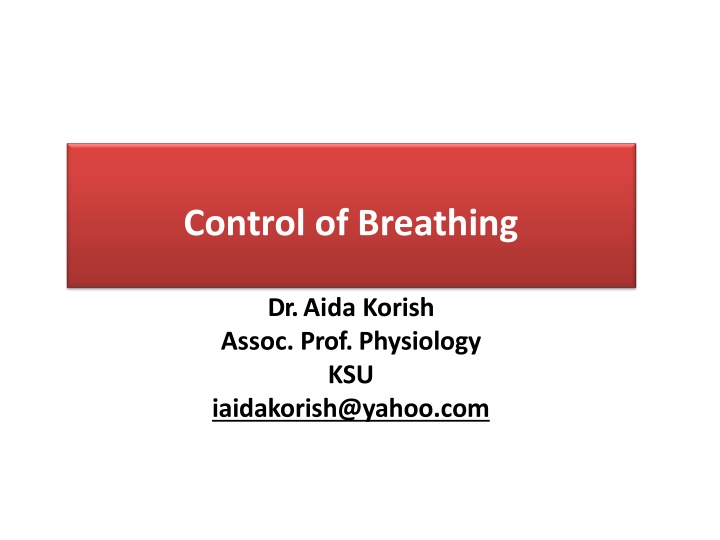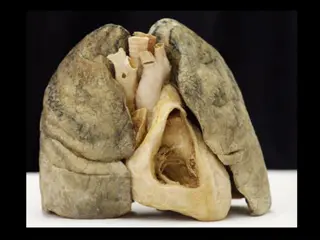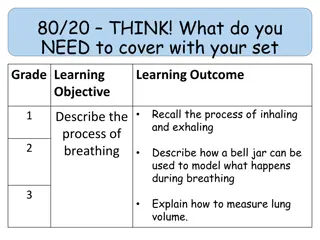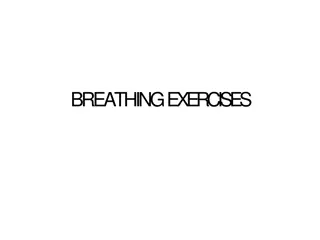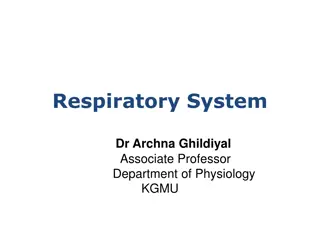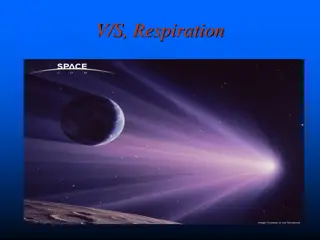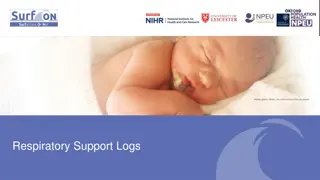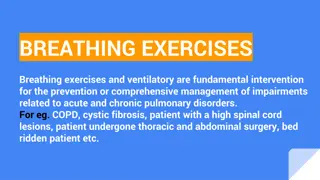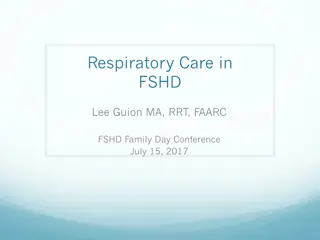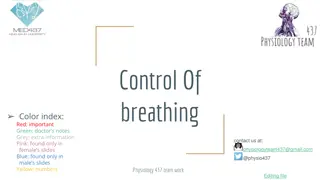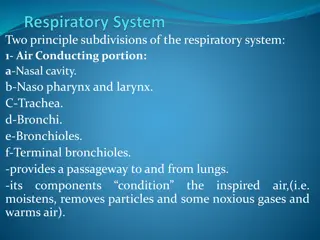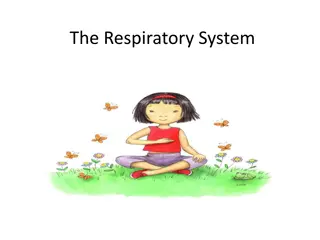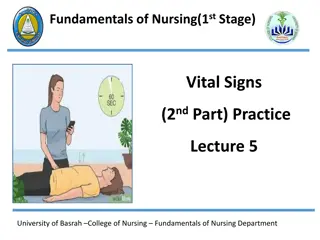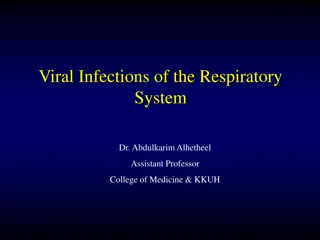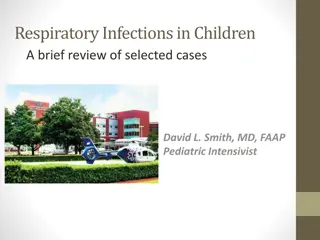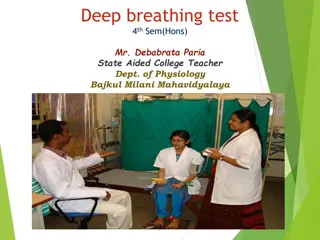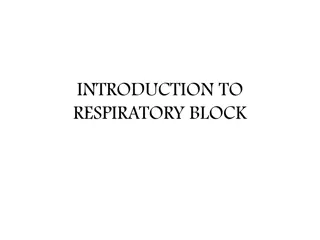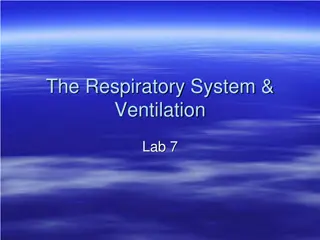Control of Breathing: Understanding Respiratory Centers
Learn about the control of breathing, including the role of the medulla oblongata, factors modifying breathing patterns, respiratory consequences of PO2, PCO2, and pH changes, and the functions of central and peripheral chemoreceptors. Explore the medullary and pontine respiratory centers and how they regulate inhalation and exhalation. Dive into the mechanisms of arterial PO2, PCO2, and pH in regulating ventilation. Enhance your knowledge of chemoreceptor control of breathing for a comprehensive understanding of respiratory physiology.
Download Presentation

Please find below an Image/Link to download the presentation.
The content on the website is provided AS IS for your information and personal use only. It may not be sold, licensed, or shared on other websites without obtaining consent from the author.If you encounter any issues during the download, it is possible that the publisher has removed the file from their server.
You are allowed to download the files provided on this website for personal or commercial use, subject to the condition that they are used lawfully. All files are the property of their respective owners.
The content on the website is provided AS IS for your information and personal use only. It may not be sold, licensed, or shared on other websites without obtaining consent from the author.
E N D
Presentation Transcript
Control of Breathing Dr. Aida Korish Assoc. Prof. Physiology KSU iaidakorish@yahoo.com
Objectives By the end of this lecture you should be able to: - Understand the role of the medulla oblongata in determining the basic pattern of respiratory activity. List some factors that can modify the basic breathing pattern like e.g. a- The Hering-Breuer reflexes, b- The proprioreceptor reflexes, and c- The protective reflexes, like the irritant, and the J-receptors. Understand the respiratory consequences of changing PO2, PCO2, and PH. Describe the locations and roles of the peripheral and central chemoreceptors. Compare and contrast metabolic and respiratory acidosis and metabolic andrespiratory alkalosis.
Controls of rate and depth of respiration Arterial PO2 When PO2 is VERY low (Hypoxia), ventilation increases Arterial PCO2 The most important regulator of ventilation is PCO2, small increases in PCO2, greatly increases ventilation Arterial pH As hydrogen ions increase (acidosis), alveolar ventilation increases.
Medullary Respiratorycenters Inspiratory area (Dorsal Respiratory Group)DRG -Determines basic rhythm of breathing -Causes contraction of diaphragm and external intercostals Expiratory area (Ventral Respiratory Group)VRG -Inactive during normal quiet breathing -Activated by inspiratory area during forcefulbreathing -Causes contraction of internal intercostals and abdominal muscles The medullary respiratory center stimulates basic inspiration for about 2 seconds and then basic expirationfor about 3 seconds (5sec/ breath = 12breaths/min).
Pontine Respiratorycenters Transition between inhalationand exhalationis controlledby: Pneumotaxic area Inhibits inspiratory area of medulla to stop inhalation. Breathing is more rapid when pneumotaxic area is active. Apneustic area Stimulates inspiratory area of medulla to prolong inhalation.
Hering-Breuer inflation reflex When the lung becomes overstretched (tidal volume is 1 L or more), stretch receptors located in the wall bronchi and bronchioles transmit signals through vagus nerve to DRG producing effect similar to pneumotaxic center stimulation Switches off inspiratory signals and thus stops further inspiration. This reflex also increase the rate of respiration as does the pneumotaxic center.
RespiratoryAcidosis RespiratoryAlkalosis Hyperventilation. Excessive loss of CO2. PCO2 decreases (35 mmHg). pH increases. Hypoventilation. Accumulation of CO2 in the tissues. PCO2increases pH decreases.
MetabolicAcidosis MetabolicAlkalosis Excessive loss of fixed acids from the body Ingestion, infusion, or excessive renal reabsorption of bases such as bicarbonate pH increases. Ingestion, production of a fixedacid. decreased renal excretion of hydrogenions. loss of bicarbonate or other bases from the extracellular compartment infusion, or The respiratory system can compensate for metabolic acidosis or alkalosis by altering alveolar ventilation
Effects of low and high gas pressure on the body Dr.Aida Korish Assoc.Prof.Physiology KSU iaidakorish@yahoo.com
Objectives By the end of this lecture you should be able to: 1-Describe the effects of exposure to low and high barometric pressures on the body. 2- Describe the body acclimatization to low barometric pressure. 3-Define decompression sickness and explain how it can beavoided. 4-Understand the effects of high nitrogen pressure, and nitrogen narcosis.
Effect of increasedbarometricpressure ( Deep seadiving). When human descend below the sea, the pressure around them increased. To prevent the lungs from collapse , air must be supplied also under high pressure. This exposes the blood in the lungs to extremely high alveolar gas pressure(hyperbarism). Under certain limits these high pressures cause tremendous alterations in the physiology of the body.
Cont.. The surrounding pressure increases by 1 atmosphere for every 10 meter (33 feet) of depth in sea water. Therefore at a depth of 31 meter ( 100 feet) in the ocean the diver is exposed to a pressure of 4 atmospheres. These problems confront contained under water breathing apparatus. SCUBA (self
Effect of depth on the volume of the gases: is compression of gases to smaller and smaller volumes. 1L (sea level ) 1/2 L at 33 feet and so on Effect of depth on density of gases increase in density of gas and hence increased work of breathing. Nitrogen effect at high nitrogen pressure has 2 principle effects: * Nitrogen narcosis ( anesthetic effect) * Decompression thickness.
Nitrogen narcosis Nitrogen like most other anesthetic gases, dissolve freely in the fats of the body including the membranes and other lipid structures of the neurons. This leads to alteration of the electrical conductance of the membranes, reduces subsequent narcosis develops. At 120 feet: the diver lose many of his cares. At 150 feet: there is a feeling of euphoria and drowsiness and impaired performance. At higher pressure: loss of coordination and finally coma might develop. their excitability and
Decompression sickness ( Cassions disease) It is a syndrome caused by a decrease in the ambient pressure which occur in animal and men when the tissues of the body contain an excess of physically inert gas. During descent , the high partial pressure of nitrogen (encountered when breathing compressed air at depth) forces this poorly soluble gas into solution in body tissue particularly in fat ( it has a high N2 solubility). On ascending, this inert gas comes out of physical solution forming a gaseous phase (bubbles), leading to symptoms and signs.
Cont.. Decompressionsickness During slow ascent N2 is slowly removed from the tissues since the partial pressure there is higher than that in the arterial blood and alveolar gas. If decompression is rapid bubbles of gaseous nitrogen are released, in tissues and blood, causing the symptoms of decompression sickness (the bends or caisson disease)
Symptoms & signs of decompression sickness(DS) The mildest form of DS is fatigue or drowsiness after decompression. Locally there is skin itch Other sever symptoms may occur e.g.: bubbles in the tissues cause sever pains particularly around the joints. Neurological symptoms include paresthesia, itching, paralysis, and inner ear disturbances.
Cont..DS Thoracic pains: dyspnea, substernal pain, cyanosis, and cough. Bubbles in the coronary arteries may cause myocardial damage. Decompression sickness shock, capillaries become permeable hypovolemia rapidly develop. Edema may be prominent and shock is also usually complicated by pulmonary edema to plasma and
Treatment of decompression symptoms Rapid recompression in a pressure chamber followed by slower decompression. This reduces the volume of the bubbles and forces them back into solution. In a very deep dives, the risk of decompression sickness can be reduced if a helium-O2 mixture is breathed during the dive..
Cont.. Treatment of DS Helium is more desirable than nitrogen indeep dives because ithas: -1/5 the narcotic effect of nitrogen on CNS. 1/7 the molecular weight of nitrogen. low density leading to decreased air way resistance ofdiver. High diffusion through tissues. Helium is about 1/2 as soluble as nitrogen in body fluids. This reduces the quantity of bubbles that can form in tissues decompressed after diving when the diver is
Effects of low oxygen pressure on the body ( Aviation-ascend to high altitude) At the sea level the barometric pressure is 760 mmHg. At 10,000 feet is 523 mmHg At 50,000 feet87 mmHg. This decrease in barometric pressure is the basic cause of all the hypoxia problems in high altitude in physiology.
Alveolar PO2 at differentaltitudes As the barometric pressure decreases, the oxygen partial pressure decreases proportionally, remaining less than 21 % of the total barometric pressure. At sea level PO2= 159 mmHg. At 20,000 feet PO2= 40 mmHg. At 50,000 feet PO2= only 18 mmHg.
Cont Even at high altitude CO2 is continuously excreted from the pulmonary blood into the alveoli. Also, water vaporizes into the inspired air from the respiratory surfaces. Therefore, these two gases dilute the oxygen in the alveoli, thus reducing the oxygen concentration and therefore hypoxia develops.
Effects of acute hypoxia Some of the important acute effects of hypoxia beginning at an altitude of approximately 12,000 feet, are: Drowsiness, lassitude, mental and muscle fatigue, sometimes headache, occasionally nausea and sometimes euphoria. All these progress to a stage of twitching or convulsions above 18,000. Above 23,000 feet the un acclimatized person can enter into coma.
Acclimatization to low PO2 A person remaining at high altitudes for days , weeks or years becomes more and more acclimatized to low PO2. So that it causes fewer deleterious effects on the body and it becomes possible for the person to work harder without hypoxic effects or to ascend to still higher altitude.
Principle means ofacclimatization 1- Increase in pulmonary ventilation. 2- Increased red blood cells. 3-Increased diffusing capacity of the lungs. 4- Increased vascularity of the tissues. 5-Increased ability of the cells to utilize oxygen despite the lowPO2.
